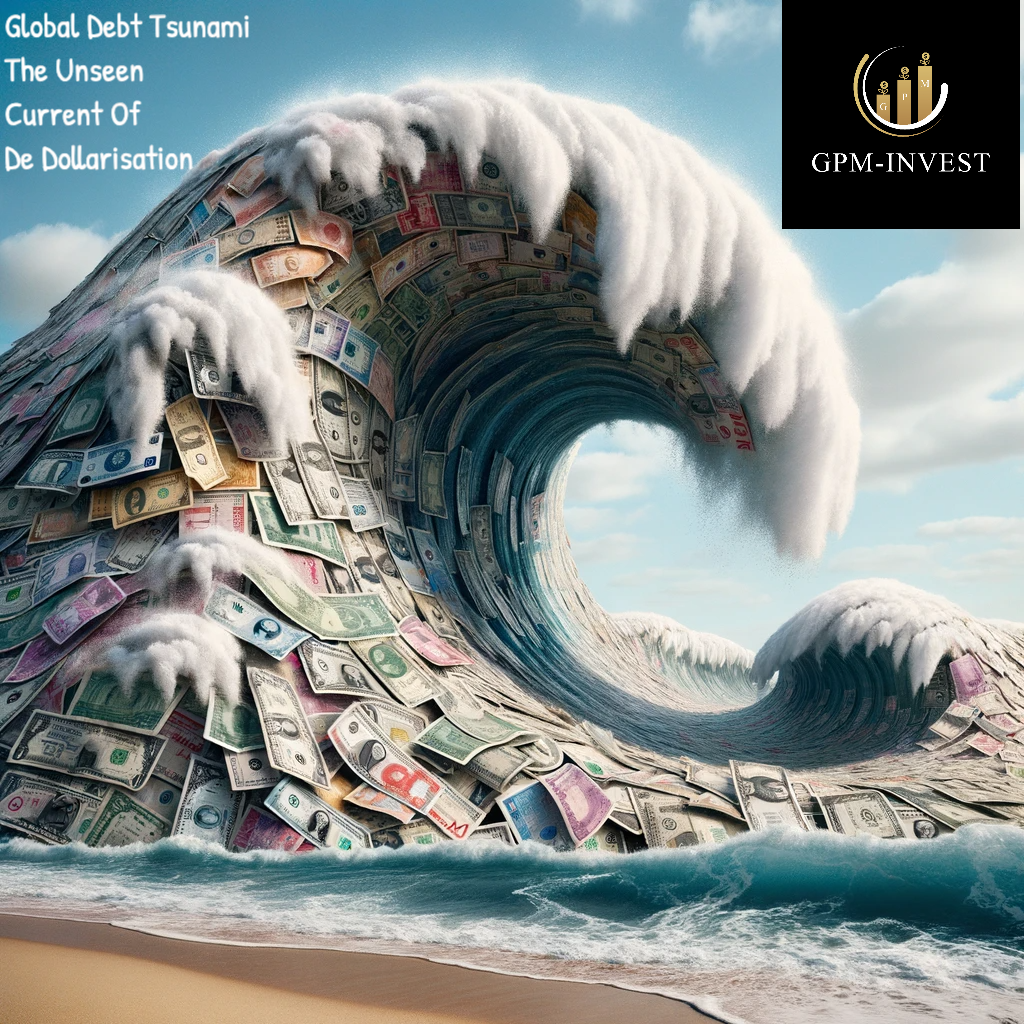Digital Zeitgeist – Global Debt Tsunami: Navigating the Unseen Currents of Imminent De-Dollarisation
Introduction: A Fiscal Precipice
As the fiscal landscape becomes increasingly precarious, the world’s attention is sharply drawn to an alarming milestone: global debt soaring to an unprecedented $307 trillion in 2023, as disclosed by the Institute of International Finance. With this colossal sum underscored by borrowing across governments, corporations, and individual households, the implications are profound, threatening the very fabric of the global financial system and potentially hastening the phenomenon of de-dollarisation.
- Unpacking the Debt Quagmire: Origins and Implications
In a world still grappling with the aftershocks of the COVID-19 pandemic, the escalation in global debt is hardly an aberration. The pandemic necessitated substantial government spending to buoy flagging economies, inadvertently contributing to a debt pile-up. What’s startling, however, is the speed and scale of this increase. From a formidable $226 trillion in 2020 to a staggering $303 trillion in 2021, and now, $307 trillion, the ascent is not only relentless but perilous.
The International Monetary Fund (IMF) reveals this trajectory as the steepest surge since World War II, raising the global debt-to-GDP ratio to an alarming 336% for two sequential quarters. Developed nations, particularly the US, Japan, the UK, and France, are the primary contributors to this scenario, reflecting deeper systemic issues within global financial practices.
- Inflation: The Hidden Culprit
Behind the scenes, an insidious actor plays a substantial role: inflation. The resurgence of inflation has been stark and somewhat unexpected, emanating from disrupted supply chains, pent-up demand, and expansive fiscal policies. Central banks, traditionally guardians against price instability, find themselves in a Catch-22. They’ve resorted to hiking interest rates, but this remedy begets another malady — augmented debt servicing costs.
These dynamics create a vicious cycle for economies worldwide. As the World Bank highlights, emerging economies are particularly vulnerable, often culminating in “protracted recessions, high inflation, and diminished resources for critical sectors.”
III. The Human Cost: Debt’s Collateral Damage
Debt is not just a cold statistic; it’s a reality impacting billions. The IMF forewarns that over 100 countries, in their struggle to service debts, will likely curtail critical public spending. The domino effect on everyday lives — encompassing healthcare, education, and basic services — can be profound, disproportionately impacting the most disadvantaged populations.
The corporate sector isn’t immune either. Businesses burdened with loan repayments compromise expansion and job creation, whereas households buckle under financial strain, curtailing basic expenses. The fabric of society, particularly for low-income families, is at risk of unravelling.
- De-Dollarisation: A New World Order?
This unfettered rise in global debt and the consequent financial instability isn’t just an economic conundrum; it’s a geopolitical one. The burgeoning debt, notably in the US — the world’s largest economy — coupled with inflationary pressures, casts doubts on the dollar’s hegemony.
Countries and central banks may reassess their reliance on the US dollar, prompting significant shifts towards alternative currencies or assets, a process known as de-dollarisation. This isn’t theoretical; it’s already underway. Nations like Russia and China have been consistently reducing their US Treasury holdings, seeking refuge in assets like gold or attempting to elevate their currencies’ status.
The consequences of accelerated de-dollarisation are multifaceted. It could potentially undermine the US’s geopolitical clout, given the dollar’s role as a lever of international influence. Moreover, a move away from the dollar in trade and reserves could exacerbate market volatility, disrupt long-standing financial relationships, and potentially reconfigure the global economic hierarchy.
- Conclusion: Navigating Uncharted Waters
The intersection of skyrocketing global debt, inflation, and the spectre of de-dollarisation presents uncharted challenges. While immediate repercussions involve socioeconomic strain, particularly in emerging economies, the long-term implications may echo through the corridors of global power, potentially redrawing the world’s financial and geopolitical map.
There’s no panacea for the quandaries posed by the debt crisis and de-dollarisation. However, multilateral cooperation, prudent fiscal policies, and structural reforms are critical to mitigating these risks. As we stand at this fiscal precipice, the choices made by governments, financial institutions, and policymakers will indelibly shape the global economic landscape of the future.
This crisis isn’t just about numbers on a balance sheet; it’s about the well-being of nations and the future structure of international power. The world is at a critical juncture, and the path chosen now will determine the global order for generations to come.
Disclaimer: The views and opinions expressed in this article are those of the author and do not necessarily reflect the official policy or position of GPM-Invest or any other organisations mentioned. The information provided is based on contemporary sourced digital content and does not constitute financial or investment advice. Readers are encouraged to conduct further research and analysis before making any investment decisions.

